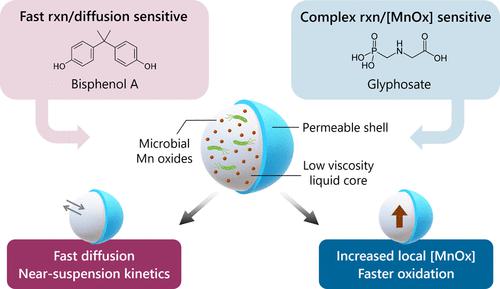当前位置:
X-MOL 学术
›
ACS Appl. Mater. Interfaces
›
论文详情
Our official English website, www.x-mol.net, welcomes your
feedback! (Note: you will need to create a separate account there.)
Liquid-Core Encapsulation of Biogenic Mn Oxides for Improved Oxidation Kinetics of Organic Pollutants
ACS Applied Materials & Interfaces ( IF 8.3 ) Pub Date : 2023-06-01 , DOI: 10.1021/acsami.3c01776 Yael Zvulunov 1 , Adi Radian 1
ACS Applied Materials & Interfaces ( IF 8.3 ) Pub Date : 2023-06-01 , DOI: 10.1021/acsami.3c01776 Yael Zvulunov 1 , Adi Radian 1
Affiliation

|
Nano- and micron-sized catalysts are continuously being discovered as efficient tools for pollutant oxidation. Their small size motivates their entrapment in beads or capsules for easier handling, but this is normally followed by reduced reaction kinetics due to slower mass transfer within the encapsulation matrix. In this study, liquid-core encapsulation was explored as a way to overcome this limitation. Biogenic manganese oxides (BioMnOx) were chosen as representative catalysts of interest, and two organic pollutants, glyphosate and bisphenol A, were used as model substrates. Different capsule compositions were examined to ensure rapid diffusion with high preservation of oxides and the oxide-forming bacteria. Glyphosate oxidation was found to follow the reported behavior of abiotic birnessite and was highly dependent on pH and oxide concentration. Thanks to the strong relationship between oxidation kinetics and oxide levels, the BioMnOx localized inside the capsules removed glyphosate significantly faster than suspended oxides, and their reuse for several treatment cycles was demonstrated. Bisphenol A, which is more sensitive to diffusion rates than to oxide concentrations, was removed by encapsulated BioMnOx at nearly the same speed as in suspension. Such encapsulation allows simple separation and concentration of reactive surfaces and enables fast transport of substrates in and transformation products out of the capsule, making it a promising way to simplify the use of suspended catalysts at improved performance.
中文翻译:

生物源氧化锰的液芯封装以改善有机污染物的氧化动力学
不断发现纳米和微米尺寸的催化剂作为污染物氧化的有效工具。它们的小尺寸促使它们被包埋在珠子或胶囊中以便于处理,但这通常会由于包封基质内的传质速度变慢而导致反应动力学降低。在这项研究中,液芯封装被探索为克服这一局限性的一种方法。选择生物锰氧化物 (BioMnOx) 作为感兴趣的代表性催化剂,并使用两种有机污染物草甘膦和双酚 A 作为模型底物。检查了不同的胶囊组合物以确保快速扩散并高度保存氧化物和氧化物形成细菌。发现草甘膦氧化遵循非生物水钠锰矿的报告行为,并且高度依赖于 pH 值和氧化物浓度。由于氧化动力学和氧化物水平之间的密切关系,位于胶囊内的 BioMnOx 去除草甘膦的速度明显快于悬浮氧化物,并证明了它们可重复用于几个处理周期。双酚 A 对扩散速率比对氧化物浓度更敏感,它被封装的 BioMnOx 以几乎与悬浮液相同的速度去除。这种封装允许反应表面的简单分离和浓缩,并能够将底物快速传输到胶囊中并将转化产物快速传输出胶囊,使其成为一种有前途的方法,可以简化悬浮催化剂的使用,提高性能。由于氧化动力学和氧化物水平之间的密切关系,位于胶囊内的 BioMnOx 去除草甘膦的速度明显快于悬浮氧化物,并证明了它们可重复用于几个处理周期。双酚 A 对扩散速率比对氧化物浓度更敏感,它被封装的 BioMnOx 以几乎与悬浮液相同的速度去除。这种封装允许反应表面的简单分离和浓缩,并能够将底物快速传输到胶囊中并将转化产物快速传输出胶囊,使其成为一种有前途的方法,可以简化悬浮催化剂的使用,提高性能。由于氧化动力学和氧化物水平之间的密切关系,位于胶囊内的 BioMnOx 去除草甘膦的速度明显快于悬浮氧化物,并证明了它们可重复用于几个处理周期。双酚 A 对扩散速率比对氧化物浓度更敏感,它被封装的 BioMnOx 以几乎与悬浮液相同的速度去除。这种封装允许反应表面的简单分离和浓缩,并能够将底物快速传输到胶囊中并将转化产物快速传输出胶囊,使其成为一种有前途的方法,可以简化悬浮催化剂的使用,提高性能。并证明了它们可以重复使用几个治疗周期。双酚 A 对扩散速率比对氧化物浓度更敏感,它被封装的 BioMnOx 以几乎与悬浮液相同的速度去除。这种封装允许反应表面的简单分离和浓缩,并能够将底物快速传输到胶囊中并将转化产物快速传输出胶囊,使其成为一种有前途的方法,可以简化悬浮催化剂的使用,提高性能。并证明了它们可以重复使用几个治疗周期。双酚 A 对扩散速率比对氧化物浓度更敏感,它被封装的 BioMnOx 以几乎与悬浮液相同的速度去除。这种封装允许反应表面的简单分离和浓缩,并能够将底物快速传输到胶囊中并将转化产物快速传输出胶囊,使其成为一种有前途的方法,可以简化悬浮催化剂的使用,提高性能。
更新日期:2023-06-01
中文翻译:

生物源氧化锰的液芯封装以改善有机污染物的氧化动力学
不断发现纳米和微米尺寸的催化剂作为污染物氧化的有效工具。它们的小尺寸促使它们被包埋在珠子或胶囊中以便于处理,但这通常会由于包封基质内的传质速度变慢而导致反应动力学降低。在这项研究中,液芯封装被探索为克服这一局限性的一种方法。选择生物锰氧化物 (BioMnOx) 作为感兴趣的代表性催化剂,并使用两种有机污染物草甘膦和双酚 A 作为模型底物。检查了不同的胶囊组合物以确保快速扩散并高度保存氧化物和氧化物形成细菌。发现草甘膦氧化遵循非生物水钠锰矿的报告行为,并且高度依赖于 pH 值和氧化物浓度。由于氧化动力学和氧化物水平之间的密切关系,位于胶囊内的 BioMnOx 去除草甘膦的速度明显快于悬浮氧化物,并证明了它们可重复用于几个处理周期。双酚 A 对扩散速率比对氧化物浓度更敏感,它被封装的 BioMnOx 以几乎与悬浮液相同的速度去除。这种封装允许反应表面的简单分离和浓缩,并能够将底物快速传输到胶囊中并将转化产物快速传输出胶囊,使其成为一种有前途的方法,可以简化悬浮催化剂的使用,提高性能。由于氧化动力学和氧化物水平之间的密切关系,位于胶囊内的 BioMnOx 去除草甘膦的速度明显快于悬浮氧化物,并证明了它们可重复用于几个处理周期。双酚 A 对扩散速率比对氧化物浓度更敏感,它被封装的 BioMnOx 以几乎与悬浮液相同的速度去除。这种封装允许反应表面的简单分离和浓缩,并能够将底物快速传输到胶囊中并将转化产物快速传输出胶囊,使其成为一种有前途的方法,可以简化悬浮催化剂的使用,提高性能。由于氧化动力学和氧化物水平之间的密切关系,位于胶囊内的 BioMnOx 去除草甘膦的速度明显快于悬浮氧化物,并证明了它们可重复用于几个处理周期。双酚 A 对扩散速率比对氧化物浓度更敏感,它被封装的 BioMnOx 以几乎与悬浮液相同的速度去除。这种封装允许反应表面的简单分离和浓缩,并能够将底物快速传输到胶囊中并将转化产物快速传输出胶囊,使其成为一种有前途的方法,可以简化悬浮催化剂的使用,提高性能。并证明了它们可以重复使用几个治疗周期。双酚 A 对扩散速率比对氧化物浓度更敏感,它被封装的 BioMnOx 以几乎与悬浮液相同的速度去除。这种封装允许反应表面的简单分离和浓缩,并能够将底物快速传输到胶囊中并将转化产物快速传输出胶囊,使其成为一种有前途的方法,可以简化悬浮催化剂的使用,提高性能。并证明了它们可以重复使用几个治疗周期。双酚 A 对扩散速率比对氧化物浓度更敏感,它被封装的 BioMnOx 以几乎与悬浮液相同的速度去除。这种封装允许反应表面的简单分离和浓缩,并能够将底物快速传输到胶囊中并将转化产物快速传输出胶囊,使其成为一种有前途的方法,可以简化悬浮催化剂的使用,提高性能。











































 京公网安备 11010802027423号
京公网安备 11010802027423号